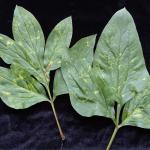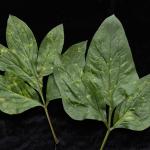Tobacco rattle virus (TRV) was observed on peonies in Western Massachusetts this week. This virus has a wide host range, affecting over 400 plant species in 50 families. Peony, bleeding heart, astilbe, hosta, epimedium, and coral bells are among the many ornamental hosts. Many vegetable crops and weeds are also susceptible.
Symptoms of TRV can vary according to host plant and environmental conditions. Mottling, mosaic, brown or yellow lesions, ringspots, streaks, and leaf deformities may occur. On peony and other plants, the virus often produces striking yellow ring spots and patterns of wavy lines. Some plants may remain asymptomatic. In most cases, peonies affected by TRV are not stunted and will flower normally.
TRV is transmitted by stubby root nematodes (Paratrichodorus and Trichodorus), microscopic roundworms that live in soil and feed on plant roots. The virus may also be spread mechanically on hands and tools, and by propagating infected mother plants.
There is no cure for infected plants. Remove infected plants and plant debris and dispose of everything in the trash. Disinfect tools frequently with 10% bleach or another antimicrobial solution. Use disease-free planting stock, and inspect plants carefully for symptoms before bringing them into the garden or landscape. Avoid moving soil from the infested area into other areas. Although the virus is contagious, an infected plant may exist in the garden or landscape for many years without symptoms being observed in other plants. If the problem is consistent, consider replanting with plants that are not susceptible to TRV: these include zinnia, annual phlox, sweet William, and Datura species.
- Angela Madeiras, Extension Educator and Diagnostician, UMass Extension Plant Diagnostic Lab


